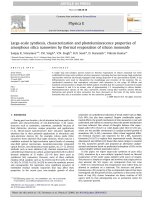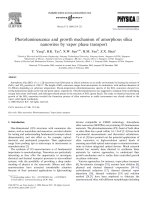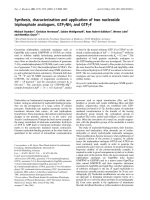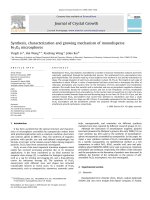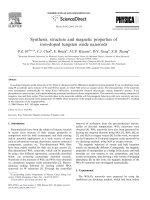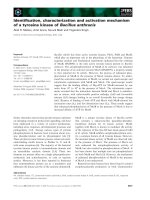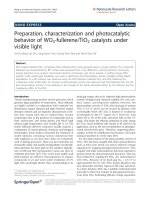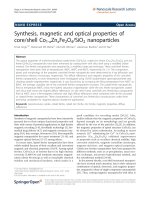- Trang chủ >>
- Khoa Học Tự Nhiên >>
- Vật lý
synthesis, characterization and growing mechanism of monodisperse fe3o4 microspheres
Bạn đang xem bản rút gọn của tài liệu. Xem và tải ngay bản đầy đủ của tài liệu tại đây (661.57 KB, 6 trang )
Synthesis, characterization and growing mechanism of monodisperse
Fe
3
O
4
microspheres
Yingdi Lv
a
, Hui Wang
a,
Ã
, Xiaofang Wang
a
, Jinbo Bai
b
a
Key Laboratory of Synthetic and Natural Functional Molecule Chemistry (Ministry of Education), Department of Chemistry, Northwest University, Xi ’an 710069, PR China
b
Laboratory MSS/MAT, CNRS UMR 8579, Ecole Centrale Paris, 92295 Chatenay Malabry, France
article info
Article history:
Received 14 January 2009
Received in revised form
8 March 2009
Accepted 31 March 2009
Communicated by S. Uda
Available online 8 April 2009
PACS:
61.10.Eq
81.16.Dn
81.07-b
81.07.Lk
81.10.Dn
Keywords:
A1. Nanostructures
A2. Growth from solutions
A2. Hydrothermal crystal growth
B1. Nanomaterials
B2. Iron oxide
abstract
Monodisperse Fe
3
O
4
microspheres assembled by a number of nanosize tetrahedron subunits have been
selectively synthesized through the hydrothermal process. The synthesized Fe
3
O
4
microspheres have
good dispersibility. The subunits made up of microspheres were uniform in size and like-tetrahedron in
shape. The average diameter of each Fe
3
O
4
microsphere is about 50–55 mm. The length of each edge of
tetrahedron is about 100 nm. A series of experiments had been carried out to investigate the effect of
reductant, precipitator and reaction time on the formation of Fe
3
O
4
microsphere and tetrahedron
subunits. The results show that ascorbic acid as reductant and urea as precipitator supplied a relatively
steady environment during the synthesis process and led to the formations of Fe
3
O
4
tetrahedron
subunit and monodisperse Fe
3
O
4
microspheres. As the reaction time increased from 3 to 24 h, the Fe
3
O
4
microspheres tended towards dispersion and becoming large in size from 10–20 to 50–55 mm, and the
subunits formed Fe
3
O
4
microspheres that varied from spheroid to tetrahedron and from a small
nanoparticle (20–30 nm) to a large one (90–110 nm). A reasonable explanation for the formations of the
Fe
3
O
4
microsphere and the tetrahedron subunit was proposed through Ostwald ripening and the
attachment growth mechanism, respectively.
& 2009 Elsevier B.V. All rights reserved.
1. Introduction
It has been accepted that the special structure and character-
istics of microspheres assembled by nanoparticles endow them
with potential application such as catalysis, medicine, electronics
and contrast agents in MIR [1]. Thus, the synthesis of magnetic
particles with specific size and well-defined morphologies has
become a hot topic in the related research field. Among magnetic
particles, Fe
3
O
4
have been extensively investigated.
Fe
3
O
4
as one of the most important transition magnetic metal
oxides has received increasing attention due to its extensive
applications. It has been considered as an ideal material for
magnetic data storage [2], a candidate for biological application
such as a tag for sensing and imaging [3], and a drug-delivery
carrier for antitumor therapy [4]. The synthesis of Fe
3
O
4
nanocrystals with different sizes and shapes has attracted
considerable interest in recent years. So a number of Fe
3
O
4
nanocrystals, such as nanoparticles, nanowires, nanorods, nano-
belts, nanopyramids, and nanotubes via different synthesis
methods have been reported by different research groups [5–11].
Although the fabrication of monodisperse magnetic particles
have been pioneered by Mati jevic’s group in the early 1980s [1 2 ],no
more attention has been paid to the synthesis of monodisperse-
sphere microparticles assemb led by nanoparticles. I n this paper, we
report a ne w synthesis method of Fe
3
O
4
microspheres assembled
by a specific nanoparticles via hydr othermal method at a low
temperatur e, in which FeCl
3
Á 6H
2
O, ascor bic acid, ure a and poly-
ethy lene glycol 6000(PEG-6000) were u sed as precursor, r eductant,
precipitator and surfactant, respectiv ely. The effects of the reductant
and the precipitator on the formation of products were discussed. In
addition, the function of the surfactants in the process of self-
assembled F e
3
O
4
microspheres was a lso i nv estigated.
2. Experimental section
2.1. Materials
Hexahydrated ferric chloride (FeCl
3
Á 6H
2
O), sodium hydroxide
(NaOH) and urea were bought from Rgent Company in Tianjin.
ARTICLE IN PRESS
Contents lists available at ScienceDirect
journal homepage: www.elsevier.com/locate/jcrysgro
Journal of Crystal Growth
0022-0248/$ - see front matter & 2009 Elsevier B.V. All rights reserved.
doi:10.1016/j.jcrysgro.2009.03.046
Ã
Corresponding author. Tel.: +86 29 8836 3115; fax: +86 29 8830 3798.
E-mail address: (H. Wang).
Journal of Crystal Growth 311 (2009) 3445–3450
ARTICLE IN PRESS
Ascorbic acid was bought from Northwest Geological Institute of
Nonferrous Metals in Xi’an. Polyethylene glycol 6000 (PEG-6000)
was bought from Kermel Company in Tianjin. All the reagents are
AR.
2.2. Synthesis methods
In a typical procedure, 0.003 mol FeCl
3
Á 6H
2
O, 0.003 mol
ascorbic acid, 0.015 g PEG-6000 and 0.6 g urea were dissolved in
a deionized water of 25ml to get an orange solution of 0.12 mol/L
Fe
3+
ions. The precursor solution was sealed into a 50ml Teflon-
lined autoclave, followed by the hydrothermal treatment at 120 1C
for 3 or 8 or 24 h and then cooled to room temperature naturally.
Three kinds of black solid products could be obtained at three
various times, respectively. These hydrothermal products would
be collected after washing with deionized water several times and
subsequently dried in vacuum at 60 1C for 6 h. The above-
described experiment conditions are denoted as the standard
condition. The other conditions (under the standard condition)
were invariable if changed the species of the precipitator or the
amounts of the reductant.
2.3. Characterizations
X-ray diffraction (XRD) patterns were recorded on a Rigaku
(Japan) D/Max r-A X-ray diffractometer with Cu K
a
radiation
(50 kV, 300 mA) at room temperature in air. Scanning electron
microscopy (SEM) images were taken with Quanta 400 ESEM-FEG
instrument operated at 25 kV, transmission electron microscope
(TEM) images were taken with JEOL JEM-3010 instrument
operated at 300 kV. They were used to characterize morphology,
particle sizes, and compositions of the products. The specific
surface areas of the samples were measured with a surface
analyzer (JW-K) by the absorption of N
2
at liquid N
2
temperature
(BET method).
3. Result and discussion
Ascorbic acid had been reported as a relatively weak reductant
in many studies [13,14]. Urea also had been reported as an
effective precipitator in the previous research due to its alkaline
reaction by slow hydrolysis at 70 1C [15,16]. This characteristic
made the pH of the reaction system change in a narrow range. So
we selected ascorbic acid as reductant and urea as precipitator. In
addition, if ascorbic acid and urea are simultaneously utilized, a
very soft reaction that favors the growth of crystal will take place.
However, the changes in the number of the reductant and the
species of precipitator would influence the synthesis of product.
3.1. Effect of reductant and precipitator
Fig. 1 shows the SEM and TEM images of the product prepared
at 120 1C for 24 h under the standard condition. Fig. 2 shows the
XRD patterns of the various products synthesized by the above-
mentioned methods in Section 2.2. It is apparent from Fig. 1a that
the Fe
3
O
4
product synthesized in this work presents in the form of
a large amount of microspheres, and all the microspheres are
monodisperse with a relatively uniform size. XRD pattern shown
in Fig. 2(a)-2 indicates the product to be a cubic-structured Fe
3
O
4
according to the standard pattern (JCPDS Card no. 85-1436,
a
=8.393 A). The average diameter of the microspheres shown in
Fig. 1b is between 50 and 55
m
m and each of them is very round.
The existing small holes and chippings were due to outside force
effect originating from SEM test on the surface of microspheres.
Fig. 1c shows an image of individual microsphere with a clear
surface and the surface is smooth. Fig. 1d reveals the specific
surface condition of the microspheres shown in Fig. 1c. The
surface of microspheres was made of a number of small subunits,
each of which is like a tetrahedron crystal in shape and uniform in
size and packed densely. Fig. 1e clearly exhibits that each of the
subunits is a nanometer size of regular tetrahedron crystal with
four symmetrical horns, and TEM imagine in Fig. 1f further
supports this result. The TEM imagine also shows that the length
of each edge of tetrahedron is about 100 nm. The selected area
electron diffraction pattern indicates the nanosize tetrahedron to
be a single-crystalline structure.
To investigate the formation factors of Fe
3
O
4
microspheres, a
series of experiments had been carried out in this work. The
results show that ascorbic acid plays an important roll in the
formation of Fe
3
O
4
microspheres. It is found that Fe
3
O
4
could
be formed in the presence of ascorbic acid, and in contrast, not
formed in the absence of ascorbic acid under the standard
condition. The reason for it may be explained that an appropriate
amount of ascorbic acid (0.003 mol), forming a gentle reductant,
could slowly reduce Fe
3+
to Fe
2+
by the following reaction
2Fe
3+
+C
6
H
8
O
6
=2Fe
2+
+C
6
H
6
O
6
+2H
2+
, and presenting a gradual
reduction effect at a moderate temperature of 120 1C; and
subsequently, the reduced Fe
3+
(Fe
2+
) and the unreduced Fe
3+
contributed to the formation of Fe
3
O
4
. The further experiment also
found that the amount of ascorbic acid was an important impact
factor in our system. As the content of ascorbic acid was increased
to 0.005 mol with other condition as constant, FeCO
3
could be
formed in the reaction system due to existing diffraction peak
assigned to FeCO
3
(JCPDS Card no. 29-696,
a
=8.393 A) in the
products, as described in Fig. 2(b). This may be due to the fact that
the increase of ascorbic acid decreased the pH value in the system
(about pH 6–5), and this relatively low pH value favored not only
the reduction of all Fe
3+
to Fe
2+
but also the reaction of urea
hydrolysis (NH
2
)
2
CO+3H
2
O=2NH
3
Á H
2
O+CO
2
, led to producing
much more CO
2
to form FeCO
3
. While the pH values were 8–9,
the content of ascorbic acid was 0.003 mol under the standard
condition. It is concluded that acidic solution was not favorable to
the formation of Fe
3
O
4
. In addition, comparing the XRD patterns
of FeCO
3
sample with FeCO
3
standard in Fig. 2(b), another crystal
phase assigned to FeO can be observed in the sample (JCPDS Card
no. 6-615,
a
=8.393 A). A reasonable explanation for it is that
the excessive ascorbic acid could reduce almost all Fe
3+
to Fe
2+
,
and formed Fe(OH)
2
due to urea hydrolysis and further generated
FeO under hydrothermal condition. This change process could be
also described as follows: Fe
2+
+2NH
3
Á H
2
O=Fe(OH)
2
+2NH
4
+
and
Fe(OH)
2
=FeO+H
2
O. As the quantity of ascorbic acid decreased to
0.001 mol in the reaction system, the XRD pattern in Fig. 2(a)-4
indicated the formation of Fe
2
O
3
. The reason may be that, on one
hand, the amount of ascorbic acid added in the reaction system
was relatively lower; on the other hand, a part of ascorbic acid in
the system reacting with O
2
dissolved in water made the amount
of ascorbic acid to be too low to reduce Fe
3+
to Fe
2+
, and finally led
to the formation of Fe
2
O
3
.
Urea as precipitator was indispensable to this reaction system,
without urea Fe
3
O
4
would not produce. As the precipitator
changed into sodium hydroxide (NaOH) the morphologies of
precipitated Fe
3
O
4
occurred change. A number of microspheres of
Fe
3
O
4
were formed in the (NaOH) system, but the surface of each
microsphere shown in Fig. 3a is not tight and rather rough. Fig. 3b
clearly shows sheet structures on the surface and there are many
interspaces among sheets. The sheets have obvious edges. It
indicates that different pH value affected the formation rate of
Fe
3
O
4
and further changed the microsphere of Fe
3
O
4
, namely, the
nucleation rate of Fe
3
O
4
could be controlled by pH [17]. One
reason for it may be that, when urea was used as precipitator, pH
Y. Lv et al. / Journal of Crystal Growth 311 (200 9) 3445–34503446
ARTICLE IN PRESS
Fig. 1. The SEM and TEM imagines of Fe
3
O
4
products synthesized at 120 1C for 24 h under the standard condition: a solution of 25 ml with 0.003 mol FeCl
3
Á 6H
2
O, 0.003 mol
ascorbic acid, 0.015 g PEG-6000 and 0.6 g urea.
Intensity (a.u.)
20
(a)-5
(a)-4
(a)-3
(a)-2
(a)-1
Intensity (a.u.)
(b)-3
(b)-1
(b)-2
2θ (degree)
30 40 50 60 70
20 30 40 50 60 70
2θ (degree)
Fig. 2. XRD patterns. (a)-1 Fe
3
O
4
after reaction for 3h and (a)-2 after reaction for 24 h with 0.003 mol ascorbic acid, (a)-3 Fe
3
O
4
standard, (a)-4 Fe
2
O
3
after reaction for 24h
with 0.001 mol ascorbic acid, (a)-5 Fe
2
O
3
standard, (b)-1 FeCO
3
standard, (b)-2 FeO standard and (b)-3 FeCO
3
product.
Y. Lv et al. / Journal of Crystal Growth 311 (200 9) 3445–3450 3447
ARTICLE IN PRESS
value in the (urea) system maintained a relative constant due to
keeping a hydrolytic equilibrium of urea hydrolyzed step-by-step,
so the nucleation rate of Fe
3
O
4
was relatively slower in urea
system than in NaOH system. This relative steady environment
during nucleation favored the formation of homogeneous and
tight Fe
3
O
4
. In contrast, pH values in NaOH system changed all
through and decreased with the nucleation time of forming Fe
3
O
4
,
and further resulted in the formation of Fe
3
O
4
microsphere with
the loose and sheet structure. The other reason may be that the
crystal seed already existed in NaOH system before Fe
3
O
4
generation due to existing OH
À
and the solid seed would
influence the morphology of final crystal; while there was no
crystal seed before Fe
3
O
4
formation in the system used urea as
precipitator, so the morphology of Fe
3
O
4
, formed by gradual
hydrolysis of urea, was more uniform in urea system than in NaOH
system.
3.2. Effect of reaction time
To have further insight into the formation process of the Fe
3
O
4
microspheres, the products formed at different reaction times of 3
and 8h were characterized by SEM observation and BET method.
The SEM images are shown in Fig. 4. Fig. 4a reveals that the
microspheres of Fe
3
O
4
formed at 120 1C for 3 h are the aggregates
of a lot of spheroidal particles (subunits) and have small opening
2μ
μ
m
50
μ
m
Fig. 3. SEM imagines of Fe
3
O
4
products synthesized at 120 1C for 24 h with a solution of 25 ml with 0.003 mol FeCl
3
Á 6H
2
O, 0.003 mol ascorbic acid, 0.015 g PEG-6000 and
0.4 g NaOH as precipitator.
200nm
dc
50μ
μ
m
a
200nm
b
Fig. 4. SEM images of Fe
3
O
4
products synthesized at 120 1C for 3 (a and b) and for 8 h (c and d) with a solution of 25 ml with 0.003 mol FeCl
3
Á 6H
2
O, 0.003 mol ascorbic acid,
0.015 g PEG-6000 and 0.6 g urea as precipitator.
Y. Lv et al. / Journal of Crystal Growth 311 (200 9) 3445–34503448
ARTICLE IN PRESS
on the surface. The size of microspheres agglomerates is about
10–20
m
m(Fig. 4a). The spheroidal subunit shown in Fig. 4bisa
uniform nanospheroid and its average diameter is around
20–30 nm. As the reaction time was prolonged to 8 h, it is
obvious from Fig. 4c that some monodisperse microspheres with a
size of 15–25
m
m can be observed and their dispersion became
better than those formed at 120 1C for 3 h. The surface of
the microspheres is incompact compared to the surface shown
in Fig. 4a and the microspheres were also the aggregates of many
of small subunits with a nanosize of 40–60nm in Fig. 4d. But the
subunit in shape was somewhat close to tetrahedron between
spheroid and tetrahedron, as the image inserted in Fig. 4d. As the
reaction time was further prolonged to 24 h a completely
tetrahedron subunit with a nanosize of 90–110 nm that made up
the monodisperse microspheres was formed, as shown in Fig. 2e
and f. Accordingly, it concludes that as the reaction time
prolonged from 3 to 24 h the aggregated microspheres made up
of subunits tended towards dispersion and becoming large in size
from 10–20 to 15–25 to 50–55
m
m again, and the subunits tended
to vary from spheroid to tetrahedron and from a small
nanoparticle (20–30 nm) to a large one (90–110 nm). But they
were still the same crystal as Fe
3
O
4
due to no difference between
the products of 3 and 24 h supported by the XRD patterns in
Fig. 2(a)-1 and (a)-2 which agreement with standard card (JCPDS
Card no. 85-1436,
a
=8.393 A). The attachment growth mechanism
may be introduced in our system. Because any nanoparticle has an
active face with high surface energy during crystal growth
process, the crystal growth preferentially occurs on this active
face [18]. So in our reaction system, one spheroidal was attached
with subsequent formed Fe
3
O
4
crystal from the four-equipotent
directions to decrease its surface area to decrease the surface
energy at maximum degree. This assumption is further confirmed
by BET results listed in Table 1. As the reaction time was 3, 8 and
24 h, the BET specific surface areas of three Fe
3
O
4
products
distinctly tended to decrease, and being 23.9174, 19.8599 and
13.6639 m
2
g
À1
, respectively. The experimental result indicates
that the surface energy was indeed the driven force of this
process. All this could be explained in Fig. 5. The spherical subunit
generated firstly at the early stage of the fast nucleation in the first
3 h. As the reaction time prolonged, a dissolution-recrystallized
process happened in this system. The formed fresh Fe
3
O
4
particle
preferentially grew on the surface of the spherical subunit from
the four-equipotent direction (step 1). As the reaction time further
prolonged, the dissolution-recrystallized process continually
occurred on the active face by overlapping layer by layer (step
2) until the subunits of tetrahedron shape were completely
formed (step 3) in order to lower-specific surface energy.
There are many reports concerning the formation mechanism
of inorganic microspheres [19,20]. The formation of microspheres
after fast nucleation in solution is related to two primary
mechanisms: random aggregation and Ostwald ripening. In the
present work, Ostwald ripening may be involved in the formation
of Fe
3
O
4
microspheres. Firstly, some Fe
3+
was reduced by ascorbic
acid to Fe
2+
in our reaction system. When the reaction tempera-
ture reached 70 1C urea hydrolysis produced OH
À
to increase pH
values in the system and subsequently the nanospheroid crystal
generated no sooner than the precipitation reaction happened.
Driven by the minimization of interfacial energy, the spheroidal
nanocrystals would act as primary building units to produce
larger self-assembled aggregates (Fig. 4a). This was a kinetically
fast process because our system was aqueous with many surface
Table 1
The results of BET surface area of Fe
3
O
4
synthesized in 3, 8 and 24 h.
Sample Reaction time (h) BET surface area/m
2
g
À1
Fe
3
O
4
3 23.9174
Fe
3
O
4
8 19.8599
Fe
3
O
4
4 13.6639
Step 1
Step 2
Step 3
Overlapping
layer by layer
Continuing
layer by layer
Fig. 5. The schematic sketch of formation process of Fe
3
O
4
tetrahedron crystal.
FeCl
3
·6H
2
O
VC Urea
+
Form Aggregation
Microspheres
Shape change
Subunits
Monodisperse Microspheres Generate
Ostwald Ripening
Microspheres
Fast Nucleation
Subunits
3h-24h
3h
24h
8h 24h
Fig. 6. The schematic sketch of formation process of microspheres.
Y. Lv et al. / Journal of Crystal Growth 311 (200 9) 3445–3450 3449
ARTICLE IN PRESS
hydroxyls and did not allow spheroidal subunit to rotate
adequately to find the low-energy configuration interface and
form perfectly single crystal [21]. These aggregates formed
microspheres and continued to grow through Ostwald ripening.
As stated early, it is obviously observed from Figs. 4 and 1 that the
size of the agglomerates changed from 10–25 to 50–55
m
m with
increasing time from 3 to 24 h (Figs. 4a and b and 1c) and the size
of the subunits varied from 20–30 to 90–110 nm (Figs. 4b, d and
1f), which was in agreement with the result of Ostwald ripening.
In addition, as the time prolonged the microsphere surface
became more and more compact in structure due to the change
of subunit in shape from spheroid to tetrahedron at the cost of
newly formed smaller Fe
3
O
4
crystal, and the microspheres became
more and more dispersed (see Fig. 2a) because of the continuous
hydrothermal process and the presence of PEG-6000. We found
that polyethylene glycol 6000 (PEG-6000) kept microspheres
monodisperse. When PEG-6000 was removed from our system
with the other condition as constant, the microspheres still
existed and most of them aggregated together. When we used
0.015 g of poly-vinylpyrrolidone (PVP) instead of PEG-6000, the
laminated structure was formed. The results show that PEG-6000
was not only acting as a surfactant but also as a molding agent.
Fig. 6 illustrates the schematic sketch of formation process of the
microsphere.
4. Conclusion
We developed a convenient method to synthesize Fe
3
O
4
microspheres assembled by nanosize subunits with a tetrahedron
structure through hydrothermal process. Ascorbic acid as reduc-
tant and urea as precipitator played an important role in the
process of Fe
3
O
4
crystal formation. Both of them supplied a
relatively steady environment, which was a crucial factor that
determined the morphologies of subunits and Fe
3
O
4
microspheres
formed by the subunits. On the other hand, the reaction time was
also an important factor that determined the dispersion of Fe
3
O
4
microspheres and the generation of tetrahedron subunits. We also
proposed a reasonable exploration for the growth mechanism of
tetrahedron subunit crystal and the aggregations mechanism of
Fe
3
O
4
microsphere in the present work. Ostwald ripening and the
attachment growth mechanism were responsible for the forma-
tion of Fe
3
O
4
microspheres and the growth of tetrahedron subunit,
respectively. The Fe
3
O
4
microsphere made up of tetrahedron
subunit for hydrogen storage as material has a potential applica-
tion value [22–24].
Acknowledgments
The present work was financially supported by the National Hi-
Tech Research and Development Program (863) of China
(2007AA05Z116), the National Natural Science Foundation of
China (20673082 and 20873099), the Scientific Research Founda-
tion for ROCS, SEM (2006331), the Key Project of Science and
Technology of Shaanxi Province (2005k07-G2) and the Natural
Science Foundation of Shaanxi Education Committee (06JK167).
References
[1] S. Laurent, D. Forge, R.N. Muller, Chem. Rev. 108 (2008) 2064.
[2] C. Pascal, J.L. Pascal, F. Favier, M.L.E. Moubtassim, C. Payen, Chem. Mater. 11
(1999) 141.
[3] H. Lee, E. Lee, D.K. Kim, N.K. Jang, Y.Y. Jeong, S. Jon, J. Am. Chem. Soc. 128
(2006) 7383.
[4] C. Alexiou, R.J. Schmid, R. Jurgons, G. Kremer, C. Bergemann, E. Huenges,
J. Biophys. Lett. 35 (2006) 446.
[5] Z.B. Huang, F.Q. Tang, J. Colloid Interface Sci. 281 (2005) 432.
[6] D.B. Yu, X.Q. Sun, J.W. Zou, Z.R. Wang, F. Wang, K. Tang, J. Phys. Chem. B. 110
(2006) 21667.
[7] R.Y. Hong, T.T. Pan, H.Z. Li, J. Magn. Magn. Mater. 303 (2006) 60.
[8] J.R. Morber, Y. Ding, M.S. Haluska, Y. Li, J.P. Liu, Z.L. Wang, R.L. Snyder, J. Phys.
Chem. B. 110 (2006) 21672.
[9] F. Liu, P.J. Cao, H.R. Zhang, J.F. Tian, C.W. Xiao, C.M. Shen, J.Q. Li, H.J. Gao, Adv.
Mater. 17 (2005) 1893.
[10] Z.Q. Liu, D.H. Zhang, S. Han, C. Li, B. Lei, W.G. Lu, J.Y. Fang, C.W. Zhou, J. Am.
Chem. Soc. 127 (2005) 6.
[11] G.F. Goya, T.S. Berquo, F.C. Fonseca, J. Appl. Phys. 94 (2003) 3520.
[12] E. Matijevic, Acc. Chem. Res. 14 (1981) 22.
[13] M.N. Nadagoda, R.S. Varma, Cryst. Growth Des. 7 (2007) 2582.
[14] Y.J. Song, R.M. Dorin, J.E. Miller, J. Am. Soc. 130 (2008) 12602.
[15] W.L. Li, H. Wang, Z.Y. Ren, G. Wang, J.B. Bai, Appl. Catal. B-Environ.
(2008) 433.
[16] K. Otsuka, T. Kaburagi, C. Yamada, S. Takenaka, J. Power Sources
(2003) 111.
[17] J.H. Zhang, Q.H. Kong, Y.T. Qian, J. Cryst. Growth 308 (2007) 159.
[18] J. Yang, H.I. Elim, Q. Zhang, J.Y. Lee, W. Ji, J. Am. Chem. Soc. 128 (2006) 11921.
[19] W. Du, X. Qian, X. Niu, Q. Gong, Cryst. Growth Des. 7 (2007) 2733.
[20] M.S. Mo, J.C. Yu, L.Z. Zhang, S K.A. Li, Adv. Mater. 17 (2005) 756.
[21] [a] A.P. Alivisatos, Science 289 (2000) 736;
[b] J.F. Banfield, S.A. Welch, H. Zhang, T.T. Ebert, R.L. Penn, Science
(2000) 751.
[22] H. Wang, G. Wang, X.Z. Wang, J.B. Bai, J. Phys. Chem. C. 112 (2008) 5679.
[23] H. Wang, S. Takenaka, K. Otsuka, Int. J. Hydrogen Energy 31 (2006) 1732.
[24] H. Wang, X.F. Wang, X.Q. Feng, Int. J. Hydrogen Energy. 33 (2008) 7122.
Y. Lv et al. / Journal of Crystal Growth 311 (200 9) 3445–34503450
